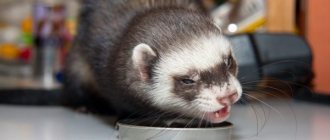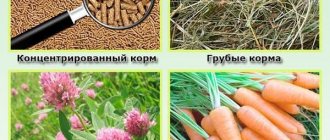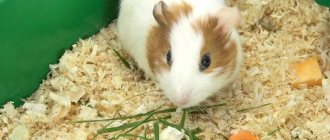In the article, we looked at the questions that owners have when introducing complementary foods to kittens. What is the best time to start complementary feeding, how and what to feed newborn kittens and kittens from one to three months. From the material you will learn which foods are prohibited for kittens to eat and why water is important for the health of the animal.
For the first three to four weeks of life, kittens feed on the milk of their mother cat. But over time, it becomes insufficient to develop properly, grow healthy and strong. At about the age of one month, kittens need to be introduced to complementary foods, which means they should begin to accustom them to adult food.
In order for kittens to grow up healthy and strong, you need to introduce complementary foods
Complementary feeding - when to start?
A small pet requires constant attention. If the owner decides to supplement the kitten’s diet, it is necessary to: analyze the health, well-being, and determine the age of the pet. A kitten needs complementary feeding at a certain age; if the animal was bought secondhand or picked up on the street, there is no need to rush to introduce meat into the diet.
The only food a mother feeds her babies for the first month and a half is breast milk. In nature, feeding with mother's milk lasts about two months, but one and a half month old kittens are already starting to try other foods.
The main rule, if you decide to adopt a kitten, is to adopt it at least 8 weeks old.
In this case, the baby will not have to be fed with formula or milk. If you decide to adopt an animal from a friend, you should wait until it grows up.
When a kitten is picked up on the street, it is difficult to independently determine its age. A veterinarian will come to the rescue. It is necessary to take the new family member to the veterinarian to find out the age, check the health, and assess the general condition. Animals taken from the street are often infected with parasites and can suffer from diseases that are dangerous to the human body.
Having determined the age, the veterinarian will advise what food it is time to give the kitten.
If:
- less than a month old - should be fed with formula milk;
- from a month to two - introduce supplementary feeding in the form of solid food;
- more than two months - feed as an adult.
If crumbs are born to a cat already living in the house, you should start feeding them no earlier than after 4 weeks.
General recommendations
If it is decided that the kittens will eat only natural food, it is advisable to accustom the pets to eating a variety of foods from the first month. You should not give your animal one product he loves and make it the main one in his diet. This can lead to digestive problems.
A great danger to a kitten's health is feeding human food in combination with ready-made food. It is also not recommended to mix expensive dry food with cheap wet food. It is better to leave only dry food, since low-quality wet food will do nothing but harm to the kitten.
Pay attention to the kitten’s fur as often as possible: if it is shiny and smooth, then the pet is healthy. If bald spots appear or the skin under the fur is irritated, you need to consult a veterinarian and purchase a special vitamin complex. But remember that in a good ready-made food, all nutrients and microelements are already balanced.
How to artificially feed?
In some cases, a situation arises when a cat refuses to feed newborn kittens, then the owner will have to feed them himself.
The best option is feeding with adapted milk formulas, which are sold in pet stores. Cow's milk and cream with various additives are also suitable.
Popular recipe: mix a glass of cow's or goat's milk at room temperature with vegetable oil (1 teaspoon), raw yolk. Beat, add honey (1 teaspoon).
Algorithm of actions:
- Prepare supplementary food. The daily norm for a newborn kitten is 22-24 ml.
- Divide feeding into 6-7 meals.
- Single dose - 3-5 ml.
- The interval between feedings is at least 2 hours.
At two weeks of age, the time between feedings should be increased by an hour; when the kitten is one month old, the number of feedings should be increased to 4 times.
Advice: for each meal you need to prepare a new portion of food; you can feed it with a pipette or pacifier. The position for breastfeeding is on the tummy.
Help the cat
The pet pleased the owners. Squeaking lumps were born. If the cat has given birth for the first time, the litter should not be too large. From 3 to 6 kids is ideal.
The mother is able to feed this number of kittens normally. If there are more of them, you will have to introduce complementary foods for the kittens, or, more correctly, supplementary feeding.
For these purposes, you can buy a cat's milk replacer. It is sold in good pet stores. It's not cheap, let's warn you right away.
You can make a substitute yourself. It is different from the store bought one, of course. But it has been tested by time and by more than one “cat person.”
- Take a liter of milk.
- Add two yolks to it.
- A teaspoon of sugar also goes here.
- Mix everything.
- Feed the kitten the heated mixture.
How to introduce complementary foods?
Kittens can be supplemented from one month of age.
- Milk porridge made from rice, semolina, and oatmeal is recommended as the first supplement.
- After a few days, you can offer boiled cereal in water, diluted with baby meat food or minced meat.
- During the week, you should increase the percentage of meat in your food, reducing the amount of cereal.
- At 8 weeks it is worth offering pure meat without added grains.
- After 8 weeks, vegetables, crushed to a puree, should be added to the diet.
Third week
Another week passes. The baby is already 21 days old. It's time to think about starting to feed kittens meat.
Previously, it was believed that babies should be given minced meat and porridge in meat broth. Now the position is different. Complementary feeding for a kitten begins with baby food. Of course, it must be meat or meat and vegetables.
Warm up the food a little. Take a teaspoon. We need half a spoonful of nutrition. We bring it to the kitten’s nose. The baby begins to actively sniff, fuss and try to lick the treat. If there is no last attempt, then take a little puree on the tip of your finger. And we pass it over the kitten’s lips. Someone recommends rubbing a treat on his palate, but on his lips - it’s more familiar and calmer. The sky can also be damaged.
Strictly follow the rule: one day - one new dish. There is no need to give your kitten porridge, meat puree and cottage cheese right away. Feed puree on Monday. On Tuesday, cook the porridge, and on Wednesday, give the cottage cheese.
Diet for feeding
By the age of one month, babies are teething, their bones are forming, and the body needs more vitamins and nutrients.
You can start complementary feeding, which consists of:
- cereal porridge with milk;
- finely chopped meat;
- boiled eggs;
- masses of cottage cheese, glucose, raw yolks;
- meat baby food.
Feeding should be done every other day, and foods should be introduced gradually in order to stop the possible development of allergic reactions in time.
Drinking regime
To digest solid food, more liquid is required, so with the introduction of complementary foods it is necessary to pay special attention to the drinking regime. Change the water in the bowl every day, and in the summer - 2 times a day. Otherwise, bacteria and other harmful microorganisms will accumulate in it.
Remember that animals can only be given bottled water from the store or filtered water. Tap water contains metals, salts and other dangerous deposits that can harm the body.
Water in the diet
The right amount of fluid is vital for metabolism. The kitten does not experience an urgent need for additional moisture if it is mother-fed. After offering additional food to your pet, make sure there is enough water in the diet.
Kittens do not like to drink water and may refuse water completely. The solution is to add water to supplementary meals. All food should be liquid in consistency. As an option: place a bowl of water next to the food, and occasionally the kids start drinking water on their own.
General Tips
To ensure your kitten grows up healthy, follow these recommendations:
- One day - one new product. Monitor your baby’s well-being and immediately remove food that is not suitable.
- Feed your animal one type of high-quality dry food, without mixing in cheap options.
- If you notice that your kitten has faded fur or frequent diarrhea, consult your veterinarian. Perhaps he needs vitamins. Buy only those prescribed by your doctor. Do not experiment on your pet!
Google, of course, knows everything. But a good doctor is even more. Take care of your furball as if it were your own child.
Source
Breed characteristics of introducing complementary foods
When compiling a diet, you need to take into account the breed and hereditary factor. Based on the experience of breeders, we can conclude that kittens of some breeds lag behind their outbred peers in development, therefore, feeding is introduced later in time.
According to their development, babies of popular (British, Scottish) breeds can receive additional nutrition as early as 4 weeks after birth.
Maine Coon cubs mature late. The mother feeds the babies until they reach two months of age. Feeding should be introduced no earlier than 8 weeks from birth.
For Sphynx cubs, additional nutrition is introduced from the age of one and a half months. Lack of hair causes the body to expend a lot of energy. Products for supplementary feeding should be high in calories.
Filler selection
As already mentioned, today there is a wide range of fillers for trays, so it is very important to make the right choice. The main recommendations regarding this issue are given below:
The main recommendations regarding this issue are given below:
- It is best to avoid clumping varieties, since these are what cats most often try to eat.
- At the initial stage, it is recommended to choose options with a neutral aroma. Scented litters are usually used later, when the cat has time to get used to its litter box.
- Fillers with a fine consistency are more suitable for small pets, since large granules are intended for adult animals.
- Wooden litters are a much better option than clay varieties as they are safer if ingested.
If you are not sure which variety is most suitable, you can purchase several different options and fill different trays with it. This will allow you to make the right choice empirically, since the kitten will independently choose the option that is suitable for it. At the same time, you should not skimp on the filler; the recommended layer thickness is about 5 cm.
If you are not sure which type of filler is most suitable, you can purchase several different options and fill different trays with it
What should you not feed?
For newborn kittens the following are prohibited:
- Raw cow's milk, food is difficult to digest in the gastrointestinal tract of a tiny animal.
- Milk diluted with water and complementary foods are not nutritious enough; the baby does not receive the required amount of microelements and vitamins.
- Kefir, fermented baked milk, sour cream, yogurt, the baby’s stomach is not able to digest.
- Sausage, meat, cheese, and other products are harmful to the body of a newborn kitten.
- Minced fish, possible parasitic infection.
Important nuances
It is important to properly organize the feeding process itself; it is worth preparing for the first feeding. It is necessary to decide where exactly the four-legged will have a place where he can eat. Over time, the baby will remember exactly where his bowl is and where he should eat. It is important that at the age of a month the baby learns to eat from a bowl. Provide your child with free access to this place and try to keep it clean.
Feeding kittens is a responsible task, since the young animal’s body is not yet adapted to normal food. You need to use the basic rules.
Basic rules of care
Of course, you no longer notice the features of your home, but a new, unknown world, full of fears and smells, opens up for your kitten. Therefore, many kittens experience a real stressful feeling when moving to a new place of residence. And your task is to brighten up the first minutes and days in which the kitten will settle into the house.
There is no need to force your friendship on the kitten or introduce it to other family members. Believe me, when the time comes, the pet will take a step forward. The only thing you need to do is introduce the baby to the bowl, tray and bed.
Can kittens be given milk: a rhetorical question
A mother cat feeds her cubs for at least 1.5-2 months. Cat milk contains all the necessary nutrients for little tails to grow quickly and have high immunity.
At the beginning of life, mother is the main source of milk
Milk composition:
- Fatty acid
- Enzymes
- Casein
- Lactose
- Low molecular weight protein
- Amino acids
- Minerals
- Vitamins
No animal organism can develop, grow and exist normally without this set of elements. Milk for kittens is a kind of building material. In babies up to 3 months old, the body produces lactase, an enzyme that breaks down milk sugar.
There are often cases when a kitten comes to its owner when it is too young. In this case, he needs to be provided with adequate nutrition, and milk is the most important point.
Kitten is a small predator
The fact that the domestic cat is a predatory animal is known to everyone from school biology lessons. Moreover, this is an obligate predator, that is, strict. Unlike dogs, who in difficult times do not disdain plant foods, in their natural habitat cats eat exclusively meat, and plant products enter their bodies only along with the entrails of herbivorous victims.
All this is sometimes forgotten when it comes to feeding kittens with dry food. Looking at the composition of some finished products intended for this category of animals, you may be surprised to notice grain components. Manufacturers use wheat, corn, rice and other grains as a cheap source of energy and plant protein.
At the same time, the share of meat products is at best 20–25%. Buying such food for feeding kittens means testing the strength of the cat’s body, “programmed” by nature to absorb completely different food.
How to find out how much meat is in the food? According to international rules, ingredients in the composition list are listed in descending order of their mass fraction. If there are a lot of meat components in the food, they will be listed first (it is advisable that there be at least three of them). And only from the middle of the list come sources of carbohydrates - in good dry food these will be vegetables, unsweetened fruits, berries, herbs.
At the end, various supplements are listed: vitamins, minerals and probiotics - their percentages are the lowest, since the body's need for them is calculated in milligrams.
Consequences of poor nutrition
Poor nutrition, especially during the growth period, is the cause of many diseases and disorders:
- Stunted growth;
- Incorrect formation of the skeleton;
- Metabolic disorders;
- Reduced immunity;
- Allergic reactions;
- Poisoning;
- Worm infestations;
- Reproductive dysfunction.
Without following the basic rules and norms of feeding, it is impossible to raise a healthy animal that meets all the characteristics of the breed.











